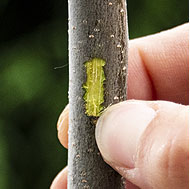Why dormant plants are the key to success

Dormant plants have natural advantages
- Ease of planting
- Increased survivability
- Better overall growth
Planting your favorite variety in its dormant state is consistent with nature's cycle of life. In addition, shipping a dormant plant is THE BEST WAY to deliver a healthy, ready-to-grow product to our customers. But what is a dormant plant? Simply speaking, a dormant plant has significantly reduced its metabolic activity in order to survive adverse conditions and emerge in spring bigger and better than before. While the plant may appear to be lifeless during this hibernation, nothing could be further from the truth. During fall these plants are letting go of "dead weight" such as blooms and foliage, while below the soil they are storing large reserves of carbohydrates. When the weather improves enough for the plants to emerge, they will use these concentrated stores of energy to begin growth.

Pictured above is a potted rose and a dormant rose one year after planting. Dormant plants establish more quickly and are more resilient.
For a gardener, dormant plants provide significant advantages over live potted plants. For starters, a plant shipped in its dormant state will allow for full enjoyment of its first blooms and foliage growth, plus it will mature faster. The best part though? Plants are way smarter than us, usually. In their dormant state, plants are truly smart in that they know what to do and when to do it. If it's too cold for a plant to leaf out when a customer receives it, the plant will wait until it knows the timing and temperatures are right. An actively growing potted plant requires much more attention to timing and conditions; for example, if a potted plant is put out when it's too cold (or conversely, too hot and sunny), the plant will suffer greatly and could even die.

Dry foliage on this dormant iris won't cause any issues. Look for a large, well-hydrated rhizome as seen here.
A proven path to success...
In a nutshell, dormant plants are not only part of nature's way, but also a better way all-around to grow plants. But don't just take our word for it. Here are some proven facts about dormant plants:
- The roots of a dormant plant acclimate more quickly to native soil conditions.
- Dormant plants are less likely to suffer dehydration. In dormant form, the plant's roots are encouraged to seek water and nutrients in their native soil (which often provides less favorable conditions than potting soil).
- They're ready to plant—no hardening off process, no risk of sunburn.
- Dormant/bareroot plants have increased survivability rates over potted plants.

By planting your favorite ornamentals in a dormant state, you'll enjoy a healthier, more vibrant display like this LA Dreamin' Hydrangea.

The buds on this hydrangea are ready to explode with growth. Notice they are not yet breaking growth—a key to proper dormant storage.
Is there an advantage over potted plants from the store?
ABSOLUTELY! Of course, not all potted plants are "bad." In fact, many of the vegetables and annuals we sell are in potted form, because they don't go into a dormant state that's conducive to shipping. But when it comes to perennials, shrubs, trees and most bulbs, the benefits of dormant over potted are indisputable.
- Dormant plants allow you to enjoy the first bloom. A potted plant bought at your local store is already halfway through its bloom cycle and more stressed during this period than if it were growing in the ground. So why pay more for potted when you and your plant miss out?
- Dormant plants will establish faster and achieve resiliency sooner than bareroot thanks to reduced transplant shock.
- Dormant plants have more potential energy for stronger growth. The buds, stems and roots of a dormant bareroot plant are packed with carbohydrate reserves, allowing the plant to explode with growth when planted. In the case of living potted plants, these reserves are used up, and they have less energy for acclimating to new planting conditions.
- Dormant plants have a stronger, more developed root system—no issues with being pot-bound.
"Don't judge a book
by its cover!"
When it comes to gardening, good things come to those who wait. In short, all that's needed is a little faith in nature and to remember that our plants have been grown, cared for and stored properly to ensure your success.
Patience is just part of the winning formula, and just like many heroic stories of our time, your magnificent plant will also start from humble beginnings.
Here are some examples of what to expect when your package arrives. Keep in mind that misshapen or discolored dormant plants, such as bulbs, are not dead or unhealthy. Just like us, plants come in all shapes and sizes, but that does not limit their potential.
"What about these weird, ugly roots?"
If you've typically purchased live potted plants, buying a dormant plant can be a much different experience. Instead of starting with a leafed out (and sometimes even blooming) plant, you will instead be greeted by what appears to be dried up plant material. There's no need to worry though. Many perfectly healthy dormant plants will look this way. Take these iris rhizomes for example...
All of these are healthy rhizomes
Shipping Stages

Dormant plants like these iris will arrive in different stages, depending on the time of year they're shipped. Dry foliage, as seen here, should be of no concern. Each of these iris will perform equally well.
Should my plant look like this?
Sometimes judging the health of a dormant plant can be difficult.
Here's a quick guide to make sure your package has arrived in ready-to-plant condition.
Trees
-

Trees will come in a variety of dormant states, from single whips (a young tree without any branches) to fully branched transplants. In the case of this apple tree, you'll look for an evenly branched tree.
-

Look for firm and plump buds that are not yet breaking growth or damaged. Also, do no be afraid of any white "fuzz" like you see here. This is not mold but rather a natural protective layer the plant creates called "pubescence."
-

To ensure the health of your tree, gently scratch away some of the bark at its base, and look for green or white hydrated flesh.
-
Check out our comprehensive
TREE PLANTING GUIDES
for even more information and videos!
Perennials and Vines
-

A healthy perennial should have firm roots that are well hydrated, but not wet or slimy. As long as the root system and crown are not dried out, it will perform well.
-

Not all perennials have "eyes", but on many varieties, you'll look for brightly colored eyes (white, green, etc.) that are firm, undamaged and not yet budding or elongating.
-

You may notice your plant has splotches or light coatings of "storage mold." As long as the roots are still firm, there is no need for concern. Storage mold will not affect the plant's growth.
-
Check out our comprehensive
PERENNIAL PLANTING GUIDES
for even more information and videos!
Shrubs
-

Like all dormant woody plants, shrubs should have strong, hydrated stems and branches that are not dried out or rotting.
-

In the case of this blueberry, you'll be looking for a well-hydrated plant with swollen buds that are firm, but not yet ready to break.
-

To ensure the health of your shrub, gently scratch away some of the bark at its base, and look for green or white hydrated flesh.
-
Check out our comprehensive
SHRUBS PLANTING GUIDES
for even more information and videos!
Bulbs
-

A healthy bulb should feel firm and weighted in accordance to its size. Avoid planting bulbs with any visible rot or excessive mold.
-

Looks aren't everything. Some bulbs may be smaller or even have scarring like this tulip. A bulb like this will still perform well and should be planted with confidence.
-

While excessive mold can be an issue, you shouldn't be concerned about light coatings of "storage mold" like this. It will not affect the plant's performance.
-
Check out our comprehensive
BULBS PLANTING GUIDES
for even more information and videos!
Tubers
-

Healthy tubers like this dahlia should be firm and feel weighted in accordance with their size. If they feel hollow, or look excessively dried out, they should be scrutinized more thoroughly.
-

Some tubers like these dahlias will not always look healthy. As long as they're well hydrated, issues like this "storage mold" will not affect their growth.
-

For tubers, size doesn't always matter. Even smaller root systems like this will perform great if properly cared for.
-
Check out our comprehensive
TUBERS PLANTING GUIDES
for even more information and videos!
MISCELLANEOUS
-

There are many unique forms of dormant plants such as this iris. Like all dormant plants, they should be firm and hydrated, without any rot or excessive mold.
-

Don't worry if the foliage on your dormant plant looks like this rhizome. As long as the fleshy portions of the root system are still firm, the plant will perform as expected.
-

On dormant plants like this iris, you might also find "pups" like these. The more pups the better, as they will help promote new growth more quickly.
-
Check out our comprehensive
PLANTING GUIDES
for even more information and videos!

